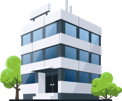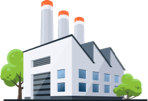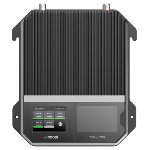Why You Can't Get Signal Inside Your Building at Work
The call is set for 2PM. You’re dialing in...and dialing in.
When you do get a connection, voice is choppy as in Twenty Thousand Leagues Under The Sea choppy. Video latency makes you feel you’re communicating in morse code.
Download speeds are slow and loading screens are forever.
“Wait a minute,” you ask yourself. “I’ve got 4G LTE, unlimited data plan from AT&T, the latest iPhone, and I’m stuck waiting for this ‘advanced technology’ to catch up?”
So why does this happen everytime you’re in any building?
While 5G, 4G, and LTE signals are generally reliable outdoors, getting a connection inside a building can oftentimes become a chore. Why? Because building material is the #1 reason why cell phone signal can’t make it inside.
We fix poor cell phone signal! Find the right signal booster for you:




Why Your Cell Phone Signal Isn’t Getting Inside Your Building
Cell phone signals are RF (radio frequency) signals. They’re the AM/FM radio and satellite communications kind used to transmit information far distances.
Cellular signal starts out strong from the source like a cell tower or cell site. But as it reaches miles in the distance to reach your phone, external obstructions like mountains, valleys, and tall trees and open air path loss weaken signal strength.
Usually when you’re outdoors in an urban area, there’s enough signal to make a call. But once you go inside a building, it becomes a dead zone, because cell signal now must also push through walls, interior building material and other interference.
The degraded signal makes it difficult to make a call, send & receive texts, or use the internet.
That’s why people in the center of a building never get reliable reception with any carrier. They’re always running to the window or outside. That’s why according to the 2018 In-Building Mobile Connectivity Report, employees inside office buildings deal with up to 44 hours a year dealing with poor cell phone signal.
Which Building Material is the Most Disruptive to Getting Good Signal
Metal by far is the worst offender with up to -50 dBm lost.
All cell phone signal operates with -50 dBm to -120 dBm. -50 dBm is full bars. -120 dBm is basically a dead zone. The closer you are to -50 dBm, the better your signal. The closer to -120 dBm, the worse your signal.
Let’s say you have -50 dBm signal outside (full bars) but have a building or factory lined with any or all types of metal: steel, aluminum, brass, copper, iron, etc. This means it can potentially subtract an additional -50 dBm once it reaches inside for a signal strength of -100 dBm (1-2 bars).
And remember, this is assuming you have PERFECT signal outside.
Most places Wilson Amplifiers have measured with good signal strength starts at -70 to - 80 dBm. Which means you literally can go from 2-3 bars of reliable 4G signal to a dead zone once you go past those doors.
Building Material / dB Loss
| Metal | -32 to -50 |
| Tinted & Low-E Glass | -24 to -40 |
| Concrete & Cement | -10 to -20 |
| Brick | -8 to -28 |
| Plaster | -8 to -16 |
| Solid wood | -5 to -12 |
| Plywood | -4 to -6 |
| Clear Glass | -4 |
| Fiberglass Insulation | -2 |
| Drywall | -2 |
Solutions for Getting STRONGER Cell Phone Signal Inside
While WiFi will always be the first option for connecting to the internet indoors. Having a strong and reliable in-building cellular connection is equally important as a secondary system when needing to connect to the internet in case of a downed or congested. WiFi network.
With the rise of faster 4G speeds and the 5G that will rival today’s WiFi networks, IT managers and facility managers are now selecting best cell phone signal boosters to improve their indoor cellular connectivity. Whereas building material subtracts dB to signal, cellular boosters add dB to signal by amplifying or bypassing building material.
Let’s look at the top options:
Active DAS (Distributed Antenna System)
DAS stands for distributed antenna system. It’s a system of antennas and remote nodes that improve cellular coverage inside any office building.
Active DAS uses fiber optic cables and converts analog RF signal to digital for longer cable runs and wider coverage. It also connects directly to the carrier network thus providing the best coverage especially for large complexes like stadiums and airports.
However, it’s expensive, with up to $5 per square foot covered and deployment time is long due to getting carrier permission and necessary requirements. Also, permission is limited to only ONE carrier at a time, so having a multi-carrier active DAS system requires 3 independent requests for permission to connect to AT&T, Verizon, and T-Mobile. Enjoy the paperwork!
Passive DAS (Distributed Antenna System)
Passive DAS pulls in off-the-air cellular signal and amplifies it to and from the cell tower. Because it is already using existing carrier signal, it does not require permission and is cheaper and faster to install–about $1 per square foot.
Passive DAS is also known as a cell phone signal booster. It’s most popular for home use; however, stronger commercial signal boosters are now entering the small medium enterprise market.
It’s not as powerful as Active DAS and is 110% dependent on the quality of outside signal. Yet it’s a cheaper option for smaller metal buildings.
Best Passive DAS (Commercial Cell Signal Booster) Solutions
Best Signal Booster For Small Businesses

- 5G-Capable
- Up to 10,000 sq ft of coverage
- Up to +72 dB of gain, with +25 dBm uplink and +15 dBm downlink
- Works with multiple cellular devices across all carriers
- LCD touch screen for greater usability
- Great for urban areas and rural
- XDR to ensure continuous connectivity
- Available in 50 Ohm and 75 Ohm variants
The weBoost Office 200 is ideal for small to mid-size business buildings struggling with reliable indoor cell service. Featuring up to 72 dB gain and high output powers, it maximizes available cell signal and delivers up to 10,000 sq ft of coverage.
Everybody in the office will be able to enjoy significantly fewer dropped calls, uninterrupted texts, and faster data speed throughout. With XDR technology, it self-regulates to prevent system shutdowns. There are multiple configurations available for urban and rural environments. A do-it-yourself installation is required.
High-Performing Professionally Installed Booster for SMBs

Professionally installed pro-grade signal booster for SMBs.
Buy Now for $3,799.99- 5G-Ready
- Up to 15,000 Sq Ft of coverage
- High-Performing 25" Outdoor Omni Antenna
- Up to 72 dB Gain and High Output Powers
- Supports All Cellular Devices and Carriers
- Works in Rural and Urban Areas
The Office 300 Installed is weBoost's latest flagship cell phone booster for SMBs. Like the Office 200 Installed, it includes a professional installation and offers up to 15,000 sq ft of coverage. However, this unit comes equipped with an all-new, high-performing 25” outdoor omni antenna. Featuring higher gain and greater range than the standard omni, it delivers the strongest cell signals possible from all available US carriers inside office buildings.
Most Powerful Signal Booster for Commercial Buildings

- 5G-ready
- Coverage up to 35,000 sq ft
- Works for all phones and all carriers
- Stronger & more reliable calls, text, email, and internet data
- Up to 16 inside antennas for wide coverage
- Up to +70 dB gain, +25 dBm uplink power and +12 dBm downlink power.
Without a doubt, the most powerful cellular signal booster ever made. The secret to the WilsonPro 4000R is the revolutionary design. Instead of 1 signal booster, the unit houses four (yes, FOUR) independent signal boosters in a rack-mount unit for IT closets or wall-mount unit.
With the need for only one outside antenna and XDR technology, which automatically adjusts for maximum gain no matter how strong or poor the signal, the WilsonPro 4000R is a clean and easy install unlike other similar signal boosting models.
Further Readings:
Wilson Amplifiers: The Trusted Name in Boosting Signal
Active or passive DAS, which is the best solution for you? Wilson Amplifiers always has the answer. Depending on the size, scope, and situation, the experts at Wilson Amplifiers can tailor a custom solution for you in time, under budget, and professionally installed.
Services we provide:
- FREE floor plan analysis with detailed heatmaps & coverage expectations.
- FREE consultation adhering to your requirements and budgets.
- Equipment selection from only the best.
- Site survey from certified wireless technicians.
- Professional turnkey installation & expert project management.
Contact us today to get the best solution for improving your 4G LTE and 5G cellular signal indoors.
Interested in Learning More? Check Out Our Signal Boosting Info Center


Money Back Guarantee

Technical Support